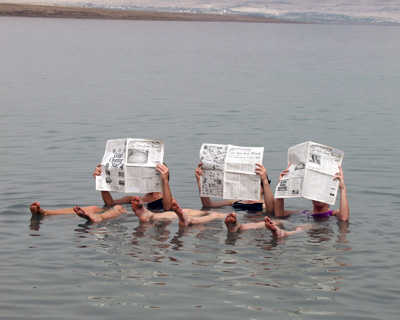Not dead yet
The Dead Body That Claims It Isn’t: I’m not dead.
The Dead Collector: What?
Large Man with Dead Body: Nothing. There’s your ninepence.
The Dead Body That Claims It Isn’t: I’m not dead.
The Dead Collector: ‘Ere, he says he’s not dead.
Large Man with Dead Body: Yes he is.
The Dead Body That Claims It Isn’t: I’m not.
The Dead Collector: He isn’t.
Large Man with Dead Body: Well, he will be soon, he’s very ill.
The Dead Body That Claims It Isn’t: I’m getting better.
Large Man with Dead Body: No you’re not, you’ll be stone dead in a moment.
— Monty Python and the Holy Grail
So it goes between John Cleese, Eric Idle and John Young.
But there is a sea, or rather lake, that is not dead yet either, feels happy, and is going for a walk on Thursday. The Dead Sea, located in the Judean Desert, roughly divided between Jordan and Israel, has a salinity of 33% – more than eight times that of seawater (3.5%). No animals or plants can survive these conditions, and the lake does look dead to the casual observer. But in the late 1930s Benjamin Elazari Volcani discovered that the Dead Sea does, in fact, support several types of microorganisms. A bit of history: Volcani’s research into microbial life in the Dead Sea led to him being awarded the the first doctoral degree in microbiology by the Hebrew University of Jerusalem, 1943. In 1975, Mullakhanbhai and Larsen named Halobacterium volcanii, a halophilic isolate, after B.E. Volcani. It is now know as the archaean, not bacterium, Haloferax volcanii.
![]()
Several other archeael isolates were found, noting that the Dead Sea is not quite dead yet. In fact, the lake sports what might be an underreported biodiversity. In addition to archaea it also has fungi, bacteria, protozoa and mermaids. OK, maybe not mermaids.
Now the Dead Sea has been found to be more alive than ever. A groups of Israeli and German divers have found freshwater springs deep in the Dead Sea. The springs are about 30m deep, and lie in of large craters 30meters in diameter. Look at the video below, taken by the divers. Between 1:54 and 2:10 you can see the freshwater mixing with the saltwater. The stark differences in salinity makes for a surreal underwater smoke effect. And, the real kicker, at 2:26 you can see a thick microbial mat, like gunk all over the rocks near the spring.
It would be very interesting to find out who, exactly, comprises this mat. As far as I know, this analysis has not been published yet. But the initial results are reported in National Geographic:
Preliminary analyses of samples collected in the craters suggest that the springs’ bacterial communities are very diverse—akin to what you’d find living on rocks in a regular saltwater sea, he added.
The top of the springs’ rocks are covered with green biofilms, which use both sunlight and sulfide—naturally occurring chemicals from the springs—to survive. Exclusively sulfide-eating bacteria coat the bottoms of the rocks in a white biofilm.
Not only have the organisms evolved in such a harsh environment, Ionescu speculates that the bacteria can somehow cope with sudden fluxes in fresh water and saltwater that naturally occur as water currents shift around the springs.
All I can say is: wow. Microbial mats in the Dead Sea, which we only find about now. The Dead Sea thriving with whole carpets of life. Who’d’ve thunk?
ELAZARI-VOLCANI, B. (1943). Bacteria in the Bottom Sediments of the Dead Sea Nature, 152 (3853), 274-275 DOI: 10.1038/152274c0
Mullakhanbhai, M., & Larsen, H. (1975). Halobacterium volcanii spec. nov., a Dead Sea halobacterium with a moderate salt requirement Archives of Microbiology, 104 (1), 207-214 DOI: 10.1007/BF00447326
Buchalo, A., Nevo, E., Wasser, S., Oren, A., & Molitoris, H. (1998). Fungal life in the extremely hypersaline water of the Dead Sea: first records Proceedings of the Royal Society B: Biological Sciences, 265 (1404), 1461-1465 DOI: 10.1098/rspb.1998.0458





















Funny, from the introduction, I thought this was going to be about the draft genome of the Black Death pathogen.